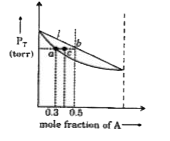The density of 1.40 molal solution of acetic acid (CH3COOH) is 1.084 g Ml−1. The molarity of solution will be a)1.30M b)1.40M c)1.50M d)1.60MSolution in Malayalam
1.30M
1.40M
1.50M
1.60M
The correct Answer is:B
Let the mass of solvent be 1kg. We will have m1=1000gandn2=1.40mol
Mass of acetic acid m2=n2M2=(1.40mol)(60gmol−1)=84g
Mass of solution, m=m1+m2=1000g+84g=1084g
Volume of solution, V=mp=1084g1.084gmL−1=1000mL=1L
Molarity of solution M=n2V=1.40mol1L=1.40M
Topper's Solved these Questions
- BOOK - BRILLIANT PUBLICATIONCHAPTER - SOLUTIONSEXERCISE - Level II50videos
SOLUTIONS
- BOOK - BRILLIANT PUBLICATIONCHAPTER - SOLUTIONSEXERCISE - Level II (Assertion & Reason Type)20videos
SOLUTIONS
- BOOK - BRILLIANT PUBLICATIONCHAPTER - SOLUTIONSEXERCISE - Level-III (Linked Comprehension Type)12videos
SOLUTIONS
- BOOK - BRILLIANT PUBLICATIONCHAPTER - SOLID STATEEXERCISE - LEVEL-3 (Linked Comprehension Type)10videos
SOLID STATE
- BOOK - BRILLIANT PUBLICATIONCHAPTER - STEREOCHEMISTRY EXERCISE - LEVEL-II (ASSERTION - REASON TYPE)2videos
STEREOCHEMISTRY
Similar Questions
The volumes of two HCl solutions A (0.5N) and B(0.1N) to be mixed for preparing 2 L of 0.2 NHCl are:
01:25View SolutionAssertion : If a liquid solute more volatile than the solvent is added to the solvent, the papour pressure of the solution may increase i.e. ps>p∘.
Reason In the presence of a more volatile liquid solute, only the solute will form the vapours and solvent will not.04:31View Solution1 mole of A and 1 mole B are mixed together to form an ideal solution at 25∘C. Solution is placed in a vessel fitted with piston. If pressure on the solution is reduced isothermally.

Correct relationship between P∘AandP∘B is04:31View SolutionF centre is an example of metal excess defect due to the presence of extra cations at interstitial sites. Zinc oxide is white in colour at room temperature, on heating it loses oxygen and turns yellow.
ZnOHeat−−→Zn2++12O2+2e−
Now there is excess of zinc in the crystal and its formula becomes Zn1+x O. the excess of Zn2+ ions move to interstitial sites and the electrons to neighbouring interstitial sites.
There are many solids which are difficult to prepare in the stiochiometric composition and contain less amount of the metal as compared to stiochiometric proportion. a typical example of this type is FeO which is mostly found with a composition of Fe0.95. it may actually range from Fe0.96 O.
Q. In Fe0.95 O:04:10View SolutionAssertion : Meso tartaric acid is optically inactive
Reason : Meso tartaric acid has a plane of symmetry03:28View SolutionThe molarity of NaNO_(3) solution is 1 M. The density of solution is 1.25 g/ml. Calculate molality of solution. (Molar-Mass of NaNO_(3)=85 g ).
03:47View Solutionजल में ऐसीटिक अम्ल के 2.05 M विलयन का घनत्व 1.02 ग्राम मिली है। विलयन की मोललता है-
01:32View Solutionजल में ऐसीटिक अम्ल के 2.05 M विलयन का घनत्व 1.02 ग्राम/मिली है। विलयन की मोललता है
02:29View SolutionThe density of a 2.05 molar solution of acetic acid in water is 1.82g/ml. The molality of the solution is
02:10View SolutionThe density of 2M solution of acetic acid (Mol. Wt. 60) is 1.02 g ml^(-1) . The molality of the solution 'X' is
02:10View SolutionDensity of a 2.05 M solution of acetic acid in water is 1.02 g/ml. The molarity of the solution is :
03:08View SolutionWhat is the molality of 2.05 molar aqueous solution of acetic acid ? The density of solution is 1.02 gram/mL.
02:08View SolutionThe molarity and molality of a solution of sulphuric acid are 11.07 and 21.91 respectively. The density of the solution in g/ml is
06:09View SolutionDensity of 2.05M solution of acetic acid in water is 1.02 g/mL, the molality of that solution is
05:04View SolutionDensity of 2.05M solution of acetic acid in water is 1.02 g/mL, the molality of that solution is
01:41View SolutionGiven that 10g of a dibasic acid (molar mass = 100) are present in 600 mL of the solution. The density of the solution is 1.02gmL−1. Molality of solution is
04:35View Solution

